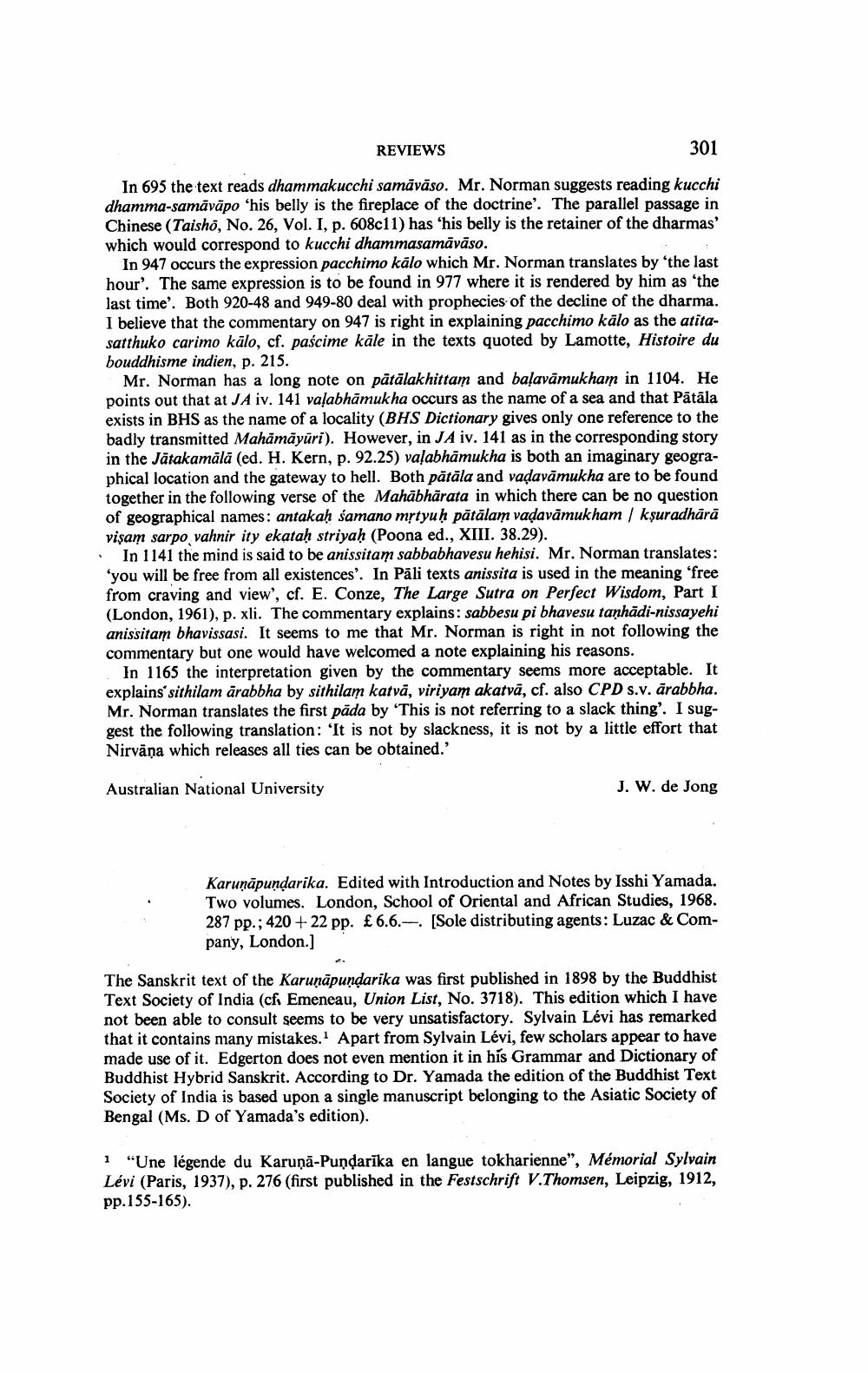Book Title: Reviews Of Different Books Author(s): Publisher: View full book textPage 5
________________ REVIEWS 301 In 695 the text reads dhammakucchi samavaso. Mr. Norman suggests reading kucchi dhamma-samavapo "his belly is the fireplace of the doctrine'. The parallel passage in Chinese (Taisho, No. 26, Vol. I, p. 608c11) has his belly is the retainer of the dharmas' which would correspond to kucchi dhammasamavaso. In 947 occurs the expression pacchimo kalo which Mr. Norman translates by 'the last hour'. The same expression is to be found in 977 where it is rendered by him as "the last time'. Both 920-48 and 949-80 deal with prophecies of the decline of the dharma. I believe that the commentary on 947 is right in explaining pacchimo kalo as the atitasatthuko carimo kalo, cf. pascime kale in the texts quoted by Lamotte, Histoire du bouddhisme indien, p. 215. Mr. Norman has a long note on patalakhittam and balavamukham in 1104. He points out that at JA iv. 141 valabhamukha occurs as the name of a sea and that Patala exists in BHS as the name of a locality (BHS Dictionary gives only one reference to the badly transmitted Mahamayuri). However, in JA iv. 141 as in the corresponding story in the Jatakamala (ed. H. Kern, p. 92.25) valabhamukha is both an imaginary geographical location and the gateway to hell. Both patala and vadavamukha are to be found together in the following verse of the Mahabharata in which there can be no question of geographical names: antakah samano mstyuh patalam vadavamukham / ksuradhara visam sarpo vahnir ity ekatah striyah (Poona ed., XIII. 38.29). . In 1141 the mind is said to be anissitam sabbabhavesu hehisi. Mr. Norman translates: 'you will be free from all existences'. In Pali texts anissita is used in the meaning 'free from craving and view', cf. E. Conze, The Large Sutra on Perfect Wisdom, Part I (London, 1961), p. xli. The commentary explains: sabbesu pi bhavesu tanhadi-nissayehi anissitam bhavissasi. It seems to me that Mr. Norman is right in not following the commentary but one would have welcomed a note explaining his reasons. In 1165 the interpretation given by the commentary seems more acceptable. It explains' sithilam arabbha by sithilam katva, viriyam akatva, cf. also CPD s.v. arabbha. Mr. Norman translates the first pada by 'This is not referring to a slack thing'. I suggest the following translation: 'It is not by slackness, it is not by a little effort that Nirvana which releases all ties can be obtained.' Australian National University J. W. de Jong Karunapundarika. Edited with Introduction and Notes by Isshi Yamada. Two volumes. London, School of Oriental and African Studies, 1968. 287 pp.; 420 +22 pp. PS 6.6.- Sole distributing agents: Luzac & Company, London.] The Sanskrit text of the Karunapundarika was first published in 1898 by the Buddhist Text Society of India (cfi Emeneau, Union List, No. 3718). This edition which I have not been able to consult seems to be very unsatisfactory. Sylvain Levi has remarked that it contains many mistakes. Apart from Sylvain Levi, few scholars appear to have made use of it. Edgerton does not even mention it in his Grammar and Dictionary of Buddhist Hybrid Sanskrit. According to Dr. Yamada the edition of the Buddhist Text Society of India is based upon a single manuscript belonging to the Asiatic Society of Bengal (Ms. D of Yamada's edition). i "Une legende du Karuna-Pundarika en langue tokharienne", Memorial Sylvain Levi (Paris, 1937), p. 276 (first published in the Festschrift V.Thomsen, Leipzig, 1912, pp. 155-165).Page Navigation
1 ... 3 4 5 6 7 8 9 10 11 12 13 14 15 16 17 18 19 20 21 22 23
